Review of Environmental Governance Research since the 18th CPC National Congress— Based on Bibliometric Analysis
Liu Wenqing & Zhou Wei*
Hainan University
Abstract: Since the 18th CPC National Congress in 2012, the “ecological civilization” concept has been steadily promoted. China has shown great resolution in green development and has achieved significant results. The awareness of environmental governance has been deeply rooted in the hearts of the people; the reform continues to accelerate, and the ecological and environmental governance work has been thriving. This paper takes CNKI (China National Knowledge Infrastructure) as the research database and analyzes published ecological and environmental governance documents since 2012. It draws scientific conclusions and suggestions through data analysis, providing references for people to understand the current situation and hot spots of ecological and environmental governance research since the 18th CPC National Congress in 2012.
Keywords: environmental protection; the 18th CPC National Congress; CiteSpace
Since the 18th CPC National Congress in 2012, the Chinese government has prioritized improving the ecological environment.The report to the 18th CPC National Congress for the first time put forward the concept of “Beautiful China” and included it in the grand goal of building an ecological civilization. The report to the 19th CPC National Congress again emphasized the basic policy of “ensuring harmony between human and nature.” Hence, we can see that China puts the building of an ecological civilization in a prominent and significant position, promoting the work of ecological environment protection. The building of an ecological civilization emerges as the times require and is based on the needs of the people. From daily eating and wearing concerns to environmental governance, from basic life to ecology, the needs of people in this new era are changing (Gao & Sun, 2021).
Xi Jinping, general secretary of the Communist Party of China Central Committee, has offered many scientific judgments on the building of an ecological civilization. He brought forward the idea that “man and nature form a community of life” (Xi, 2017), meaning that the relationship between man and nature should be harmonious and unified. He also pointed out that “when ecology prospers,civilization prospers; when ecology decays, civilization decays.” indicating a positive relationship between human civilization and the ecological environment. He once stressed that ecological and environmental governance is the seed we plant today for the benefit of the generations to come,indicating that the ecological environment plays a crucial role in influencing the progress of social civilization, concerning the happiness of the people and the future of the nation. Xi Jinping Thought on Ecological Civilization highlights the importance of ecological environmental governance.Moreover, in practice, a lot of fundamental, lasting, and original work has been carried out for ecological and environmental governance, and intensified efforts have been made to protect natural ecosystems and the ecological environment. Since the 18th CPC National Congress, the scientific conclusion that “Lucid waters and lush mountains are invaluable assets” has been widely known and remembered. The process of ecological and environmental governance has accelerated, and the effect is unprecedented.
The quality of the ecological environment has a relationship with the top-level design of environmental governance. Since the 18th CPC National Congress in 2012, many scholars have discussed and studied environmental governance as required by time and tide. To have a more detailed understanding of the efforts made by today’s scholars in environmental governance, this paper, based on bibliometrics, will use CiteSpace to analyze the documents published by scholars on environmental governance since the 18th CPC National Congress. Scientific conclusions and suggestions will be drawn based on data analysis to provide references for people to understand the current situation and hot topics of environmental governance research since the 18th CPC National Congress.
Data Sources and Research Methods
Data Sources
This paper takes CNKI (China National Knowledge Infrastructure) as the research database. This paper selected “advanced search” and retrieved published papers whose titles contain “environmental governance.” This paper intended to include relevant documents published during the period from the start of the 18th CPC National Congress (November 8, 2012) to 2020. My selection range was from 2013 to 2020. To ensure that the documents for research were pioneering, representative, and scientific, all of them came from CSSCI (Chinese Social Science Citation Index). By this standard,a total of 675 documents were collected. After manually deleting the irrelevant, such as documents studying corporate environmental governance and public opinion environmental governance and the repeated documents, 567 valid documents were finally selected as the research samples for this paper.
Research Methods
CiteSpace is the main research tool for bibliometric analysis in this paper. Based on Java, it can visualize the collected documentary information; via data mining algorithms, it can integrate the information to obtain further co-occurrence matrix of keywords, authors, and institutions (Li & Chen,2016). Therefore, CiteSpace is widely and maturely used in analyzing the development and research trends of a selected field. By analyzing the 567 selected documents via CiteSpace, this paper sorted them in a systematic and scientific way. CiteSpace is software for visualizing research documents.The “scientific knowledge map” obtained by visualization can more intuitively and effectively display the research status, hot spots, and the future development trend of environmental governance since the 18th CPC National Congress in 2012.
Research Results
The Quantity of Annual Documents
In this paper, Excel is used to analyze the research documents on environmental governance since the 18th CPC National Congress in 2012, as shown in Figure 1. The overall number of published papers goes up year by year. Based on the quantity of the published documents, we can divide the environmental governance research since the 18th CPC National Congress into three stages: From 2013 to 2015, it was in its infancy. Although annually published documents kept going up, there were not many. This showed that after the 18th CPC National Congress, the concept of environmental governance came into people’s sight. However, it had not received much academic attention at this stage, and the research efforts were relatively insufficient. The years 2016 to 2017 were a stable stage. Compared with the previous stage, environmental governance research increased; the number of published papers steadily increased, and there were significant achievements. From 2018 to 2020,environmental governance research reached its growing stage. Significant improvements were made as compared with the earlier stages. This is mainly because at the 19th CPC National Congress, Xi Jinping once again elevated the concept of “building a beautiful China” to the level of “a community with a shared future for mankind.” At the same time, he also elevated the building of an ecological civilization to “vital to sustaining the Chinese nation’s development,”indicating that the CPC Central Committee attached unprecedented importance to the building of an ecological civilization. The report to the 19th CPC National Congress pointed out that efforts should be made to solve major environmental problems, providing more precise guidelines for building a beautiful China. Under the guidance of Xi Jinping, general secretary of the Communist Party of China Central Committee,research on environmental governance has attracted more attention and research passion at this stage.This paper believes that environmental governance will remain a hot topic in building a beautiful China for a long time.

Figure 1. Distribution of the papers on environmental governance published since the 18th CPC National Congress
Distribution of Researchers and Research Institutions
Primary authors can be identified by analyzing the publication quantity (Qiu & Liu, 2014). Figure 2 obtained by CiteSpace shows the primary authors on environmental governance since the 18th CPC National Congress and the cooperation between them. Figure 2 shows most of the researchers’individual number of publications is less than ten. Wang Fang (5 papers) and Zhang Junbiao(5 papers) have published the most. Their main publications were in the period from 2018 to 2019. Following these two “highfrequency” authors were Du Yanqiang (4 papers), Ran Ran (4 papers), and Ding Lin (3 papers). The authors mentioned above can be identified as the primary forces in the field.The degree of communication and openness in environmental governance can be determined by the frequency of cooperation between researchers and research groups.Only open academic communication can better promote academic development and progress (Wang & Huang, 2015). The higher the network density, the stronger cooperation between authors. As shown in Figure 2, the network density is 0.0221, which indicates that the network density among primary authors needs to be improved and there are limited cooperative relationships. The research forces on environmental governance in China are still relatively scattered, which is not conducive to academic development and progress.
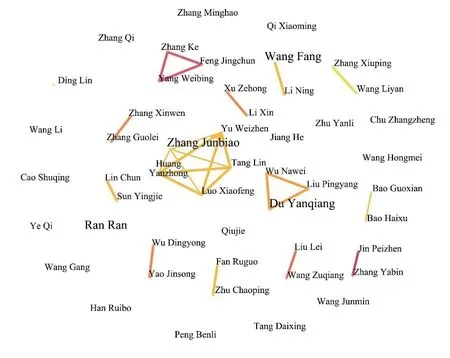
Figure 2. Distribution of primary authors of environmental governance research since the 18th CPC National Congress
The spatial distribution of research strength can also be seen from the distribution of issuing institutions. Figure 3 reflects the top 12 core research institutions in terms of publication quantity.Research Base of Ecological Civilization and Environmental Rule of Law, Kunming University of Science and Technology published the most: 9 papers. It is followed by the College of Public Administration, Nanjing Agricultural University: 8 papers. The College of Economics and Management, Huazhong Agricultural University; School of Management, Lanzhou University,Business School of Hohai University, and Hubei Rural Development Research Center also have quite impressive publications in this field: 5 papers each. These publication institutes include both universities and research bases. They play an important role in environmental governance and are the primary forces of China in researching environmental governance. From the spatial distribution of publishing institutions, we can see that environmental governance research in China is booming nationwide.
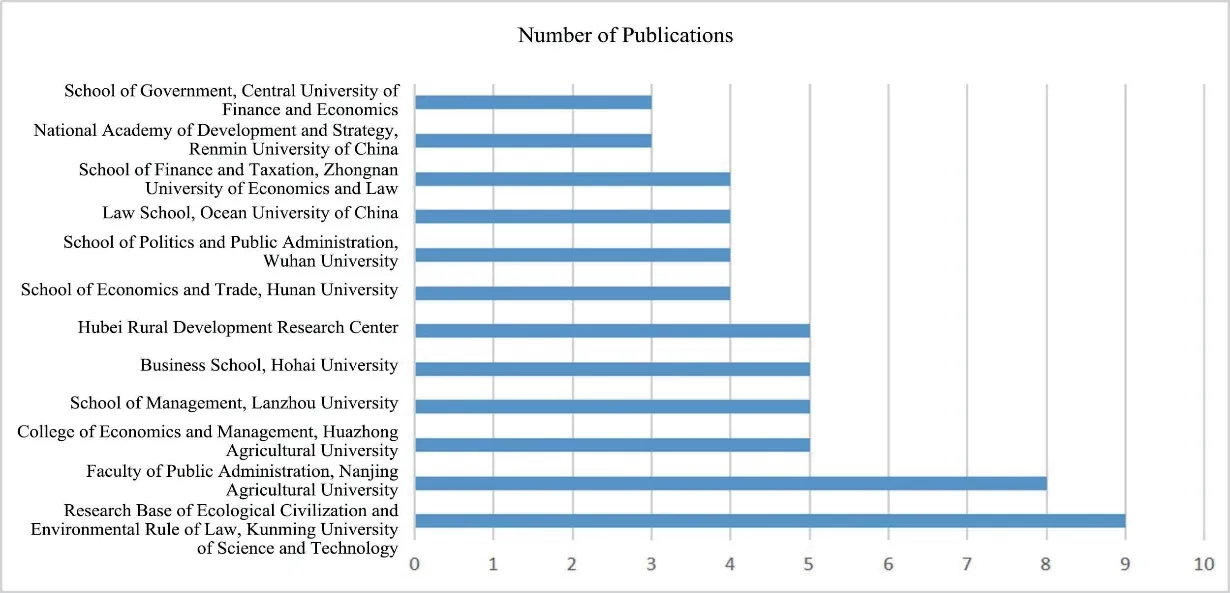
Figure 3. The distribution of publishing institutions for environmental governance research since the 18th CPC National Congress (Top 12 in terms of publication quantity)
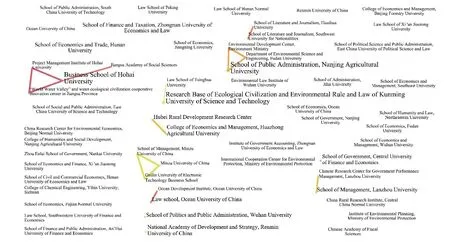
Figure 4. The co-occurrence of research institutions on environmental governance since the 18th CPC National Congress
The graph describing the institutional cooperation on environmental governance research can help us investigate the cooperation among different institutions, as shown in Figure 4. The analysis shows that the number of nodes in the graph is 59, the number of links is 15, and the network density is only 0.0088. The low network density indicates that the connections between research institutions in this field are loose, lacking cohesion. Most of the institutions are independent research institutions.Few of them have cooperative relationships. Therefore, academic exchanges and cooperations between different research institutions need improvement. Considering the geographical locations of the institutions, we can see that it is easier for institutions in the same region to form cooperative relationships. For example, the School of Economics and Management of Huazhong Agricultural University and Hubei Rural Development Research Center have cooperated and published some significant research results. In future research, it is necessary for research institutions to establish a cooperative network.
Research Hot Spots
Keywords co-occurrence.
Keywords, words that summarize the whole text, are the key to analyzing the themes of a paper.Keywords in a paper, to a certain extent, represent its research direction. Hence, we can capture the research hot spots in this field by the overall analysis of keywords. Figure 5 shows the keywords co-occurrence of papers on environmental governance from 2013 to 2020 via CiteSpace. In the keywords co-occurrence network of environmental governance research, there are 95 nodes and 96 links, and the network density is 0.0215. The circular nodes represent keywords, and the lines between nodes indicate a correlation between keywords. The higher the frequency of keywords connecting each other, the larger the node is. The size of the circle is positively correlated with the keyword occurrences in the papers. Generally, the more frequently a keyword appears, the larger the circle is. The knowledge graph of keyword co-occurrence in Figure 5 shows the research hot spots on environmental governance. As can be seen from Figure 5, those research hot spots are centered around environmental governance, and “public participation,” “local government,” and “rural environmental governance” are the key research areas.
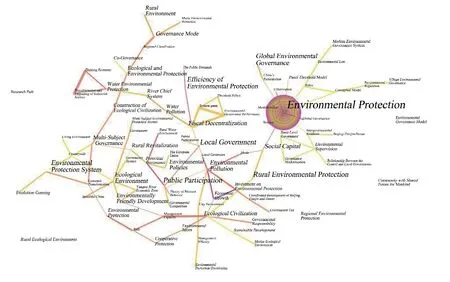
Figure 5. Knowledge graph of keywords co-occurrence of the environmental governance research
Keyword frequency.
To improve the credibility of the research data, this paper associated the keyword frequency with the centrality of keywords, taking them as the subject of the paper analysis. The frequency and centrality of keywords were generated by CiteSpace. Due to space limitations, only the top 12 highfrequency keywords were shown in this paper.

Table 1 High-frequency keywords on environmental governance and their frequency

Ranking Frequency Centrality Keywords 8 12 0.37 Fiscal decentralization 9 12 0.39 Rural revitalization 10 11 0.22 Ecosystem 11 10 0.17 Green development 12 9 0.74 Social capital
In CiteSpace betweenness centrality is a key index to discover and measure nodes, which is usually used to measure the core influence of nodes in the network. Generally, nodes with high betweenness centrality are key hubs connecting different fields. According to the algorithm of betweenness centrality provided by CiteSpace, if a node’s value is greater than 0.1, it has high betweenness centrality and has a significant influence on the cooperative network.
Based on the results shown in Table 1 and Figure 5, we can conclude that:
First, environmental pollution is the most concerned issue. As shown in Table 1, “environmental pollution” has the highest betweenness centrality of 0.9, indicating that “environmental pollution”occupies a very important position in the co-occurrence network and is closely related to other keywords. On environmental pollution issues, scholars have a lot of discussions. Through data analysis, we can see that: Wang Min and Huang Ying (2015) believe that there is no direct positive relationship between economic growth and environmental pollution; economic growth does not necessarily lead to environmental pollution. Tan Zhixiong and Zhang Yangyang (2015) have empirically studied the relationship between fiscal decentralization and environmental pollution;they concluded that areas with high fiscal decentralization have sufficient funds for environmental governance, and thus can effectively control and reduce environmental pollution. Xie Haiyan (2014)believes that third-party governance can effectively improve the efficiency of pollution control,reducing the cost and governmental financial burden.
Second, multi-subject participation of environmental governance. From Table 1, we can see that the keywords “environmental governance,” “public participation,” and “local government” have high frequency and can be regarded as the research hot spots in this field. Keywords such as “collaborative governance” and “multiple governance” in Figure 5, to some extent, are also hot spots. This is in line with the current research on the subjects of environmental governance. The complexity and systematization of environmental governance make it difficult to maintain single-subject governance modes. Environmental governance relies on the participation of the public and the efforts of local governments. Jia Wenlong (2019) believes that one important thing in environmental governance is effectively coordinating the collaborative involvement of multiple subjects. In virtue of the power of the government, the public and the markets can exploit their advantages, more effectively realizing the environmental governance. Cao Jiaoxing (2015) believes that multiple-subject governance, supported by network and information technologies, helps us better control the deterioration of the ecological environment through coordination and cooperation.
Third, rural areas are the key areas worth attention in environmental governance. Rural environmental governance is also the focus of academic discussion. Zhang Zhisheng (2020) believes that rural ecological environment protection is related to the fundamental well-being of farmers and has become an important basic measurement of the modernization of local governments’ governance.Huang Senwei, Tang Dan, and Zheng Yifang (2017) hold that the rural environment determines not only the development of rural areas but also the development of cities; it provides important resources and environmental resources for the development of the whole society.
Research Trends
By its function of generating the keyword co-occurrence, CiteSpace provides us with a graph of the time periods for keyword co-occurrence. The graph can reflect the occurrence time of keywords and whether there is co-occurrence correlation between keywords through visual analysis. Based on this, it reveals the research process in certain time periods, and then its development trend. The popup keywords in different time periods are also direct indications of the evolution of research hot spots in this field.
Figure 6 shows that scientific research in environmental governance has gone through a gradually deepening process since the 18th CPC National Congress, which can be divided into the following periods.
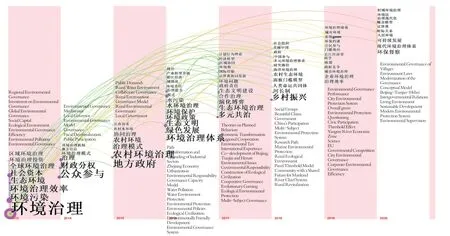
Figure 6. The graph of keyword co-occurrence in different time periods since the 18th CPC National Congress
The first is the preliminary exploration stage (2013). After the 18th CPC National Congress, the CPC Central Committee raised the issue of the ecological environment to the level of basic policies.Policies on environmental governance were launched intensively. Academic terms like “environmental governance,” “environmental pollution,” “environmental governance efficiency,” and “ecological environment” appeared, indicating that the policies have triggered passionate academic discussions. In another way, the academic discussions in turn influence the national policies and further provide solid theoretical guidance and optimizing suggestions for the government. The research carried out at this stage is still limited to preliminary exploration, and there is no significant substantive breakthrough research.
The second is the stable developmental stage (2014-2016). At this stage, high-frequency keywords began to focus on how to carry out environmental governance. The research range has been enlarged and the research depth deepened. Attentions were gradually turned from the macro “environmental governance,” “environmental pollution,” “ecological environment,” to more micro areas such as“the public participation,” “fiscal decentralization,” “local government,” “management mode,” and“environmental management system.” These newly emerged keywords indicated that academia has begun to pay close attention to the environmental governance of specific issues. They began to find ways to deal with specific problems of environmental governance. From the discussion of the main subjects of environmental governance to the study of environmental governance systems, the academic understanding of environmental governance has deepened.
The third is the research deepening stage (2017 to 2020). The emergence of keywords such as“multi-subject co-governance,” “regional synergy,” “community with a shared future for mankind,”and “cooperative governance” marks the shift of environmental governance from a single-subject mode to multi-subject cooperation. In the face of environmental issues, cooperative governance also needs to break free of the shackles of national (governmental) centralism. We need more focus on joint efforts to handle public affairs, on an individual sense of social missions, and on realizing truly diversified cooperation to achieve win-win multi-party interests at the lowest cost and effectively resolve the potential conflicts of interest, and to turn the identity of government as a crisis manager to a crisis dealing cooperator (He, 2008). With the development of society, humankind has entered an era of high complexity and high uncertainty, and cooperative governance is the general trend (Yu,2017). The academic research on the cooperation mode of environmental governance conforms to the development of the times.
According to the graph of keyword co-occurrence in different periods and the literature analysis,we can see the development trend of environmental governance since the 18th CPC National Congress.
The first is the governance mode being more cooperative. Since the 18th CPC National Congress, China has not only made achievements in the building of an ecological civilization,but also assumed the responsibility as a major country. China helped other countries jointly manage environmental issues and actively participated in environmental globalization. Xi Jinping advocates ecological and diplomatic thoughts, which are the guidance for future environmental governance. Considering the existing policies, the focus of research on ecological and environmental issues will shift to the construction of a win-win environmental governance system. Environmental issues are complicated and changeable and are still serious in China. Scholars have made great efforts in exploring regional intergovernmental cooperation in environmental governance. In addition, with the downturn of the global economy and the complex international communication and competition, China has been faced with an increasingly complicated international environment in recent years. Therefore, single-subject modes are no longer an appropriate way to deal with complexity and changeability. Cooperation in environmental governance should be the research focus in the near future.
Research objects are more complicated. From the above analysis, it can be seen that the research objects of environmental governance have changed from the macro to the micro-level. The research with macro-objects tends to ignore the regional differences, and the results of universal research may not apply to a specific practice. In this regard, scholars take particular regions as the research subjects and then specifically analyze specific situations. Figure 6 shows that keywords indicating a regional range such as “Beijing-Tianjin-Hebei” and “Yangtze River Economic Belt” appeared. It is a sign that many environmental issues in China have gone beyond land boundaries and administrative regions.Environmental issues are cross-regional; it is impossible to reveal the nature of environmental governance issues by only taking one place as a single research object. The general trend for research objects of environmental governance is becoming more complicated.
The governance method is more scientific. Keywords such as “evolutionary game,” “governance modernization,” “conceptual model,” and “panel threshold model” indicate that China’s research on environmental governance is gradually being digitized and becoming more scientific, shifting from “command-and-control” to multiple-participation, from passive to active, and from artificial to digital. With the rapid development of science and technology, environmental governance undergoes profound changes as well. Nowadays, our society has entered the era of big data, and the governance system and governance capacity have been modernized. Environmental governance inevitably needs fundamental reforms, as do the research methods, research ideas, and data collection. Environmental governance is no longer carried out by the decisions drawn from experience and intuition, but by scientific conclusions drawn from the analysis and application of big data. Therefore, researchers should use the methods of scientific thinking and data analysis for breakthroughs in environmental governance research.
Conclusion and Prospect
This paper used CiteSpace to study and analyze relevant documents on environmental governance since the 18th CPC National Congress and classified the characteristics, research hot spots, and research trends found in the selected, relevant documents. The research shows that since the 18th CPC National Congress, the publication of environmental governance research has been increasing year by year. Since the 18th CPC National Congress, China’s environmental governance research has gone through the infancy and stable stages and is now growing. In terms of research forces, the cooperation between primary authors and major research institutions is not close. The research forces of environmental governance in China are still relatively scattered, which is not conducive to academic development and progress. In terms of research hot spots, environmental pollution, multi-governance,and rural environmental governance are key research areas. In terms of research trends, it can be seen from the graph of the time periods of keyword co-occurrence that research on environmental governance since the 18th CPC National Congress has experienced a preliminary exploring stage(2013), a stable developmental stage (2014-2016) and a research deepening stage (2017-2020); and further research is continuing at a growing rate. At the same time, since the 18th CPC National Congress, the research on environmental governance has shown a progressive trend as governance modes become more cooperative, together with research objects more complicated and governance methods more scientific.
Since the 18th CPC National Congress, fruitful research results on environmental governance have been achieved in China. With the overall analysis above, This paper hopes that: First, the communication between the authors and institutions will be strengthened so the sharing of information and resources will be expanded, which will enrich environmental governance research and promote joint developments. Second, based on the connections between research hot spots,researchers should keep expanding the research range, promoting inter-disciplinary interactions, and strengthening diversity and comprehensiveness by multi-disciplinary and multi-perspective analyses.Third, researchers should keep up with the forthcoming policies, take specific Chinese situations into consideration, bring up new research ideas based on the cognition of the informationization and scientization of the era, and offer theories and scientific suggestions for building an ecological civilization.
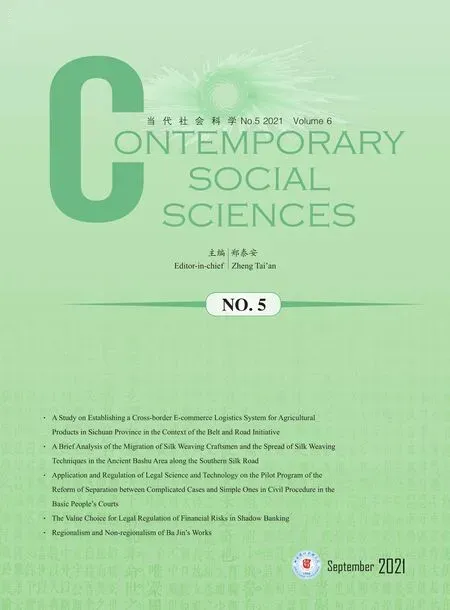 Contemporary Social Sciences2021年5期
Contemporary Social Sciences2021年5期
- Contemporary Social Sciences的其它文章
- 《当代社会科学(英文)》稿件格式参考Manuscript Format
- Research and Analysis on the Origin of the Term “Xinche” in Traditional Chinese Medicine and Its Translation
- A Study of the Pit-Aided Construction of Egyptian Pyramids
- The Significance of Inter-Cultural Communication of “Panda Fever”— A Case Study of “Meng Meng” and “Jiao Qing” in Berlin
- Application and Regulation of Legal Science and Technology on the Pilot Program of the Reform of Separation between Complicated Cases and Simple Ones in Civil Procedure in the Basic People’s Courts
- A Study on Establishing a Crossborder E-commerce Logistics System for Agricultural Products in Sichuan Province in the Context of the Belt and Road Initiative
